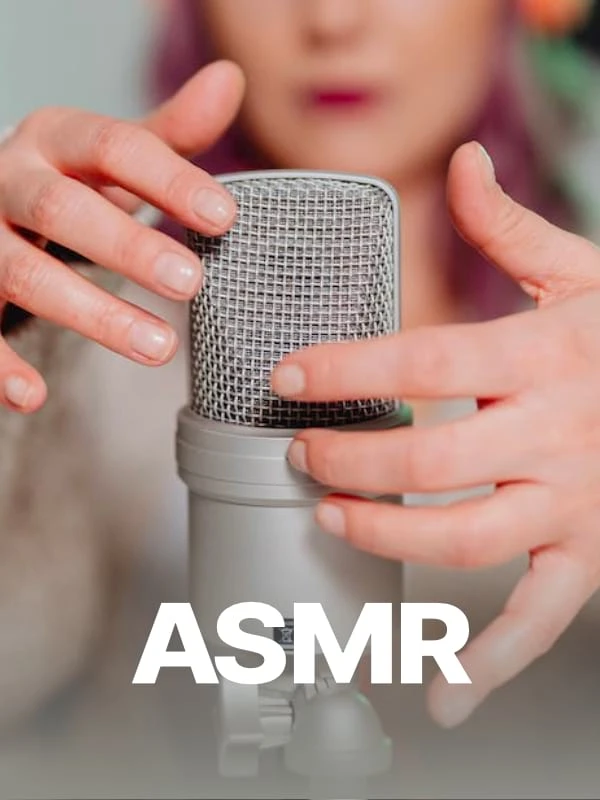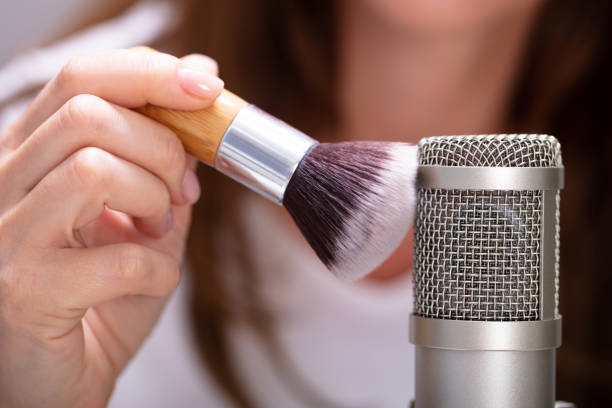ASMR, or autonomous sensory meridian response, has taken the internet by storm, captivating millions with its soothing sounds and gentle visuals. From hair brushing to whispers, these sensory experiences elicit a unique tingling sensation that many find deeply relaxing.
If you follow social media, you may have noticed a few of the more than 13 million ASMR videos online. Many of the videos create ASMR-inducing sounds to play out social situations with actions that may trigger a response. But what exactly is ASMR, how does it work, and why has it garnered such immense popularity?
Table of Contents
What Is ASMR?

ASMR stands for autonomous sensory meridian response, a term describing a unique tingling sensation. It usually begins on the scalp and often moves down the neck and spine. Many people experience it in response to specific audio or visual stimuli. These triggers can include whispering, tapping, or gentle brushing.
Some individuals feel relaxed, calm, or sleepy while experiencing ASMR. This sensation can create a sense of well-being, making it a popular way to unwind. Not everyone can experience ASMR, but those who do often seek out videos tailored to their triggers. This widespread phenomenon continues to intrigue researchers and viewers alike.
History of ASMR
The history of ASMR is relatively recent, although the sensations it describes have likely been experienced for centuries. The term “ASMR” was coined in 2010 by Jennifer Allen, who sought to provide a non-scientific label for the tingling sensations many people felt. Early discussions about ASMR began in online forums, where individuals shared their experiences and discovered common triggers.
These conversations eventually led to the creation of ASMR content on YouTube. Over time, ASMR grew from a niche interest into a widespread phenomenon, with countless videos and dedicated creators. The community continues to evolve, driven by a collective desire for relaxation and well-being.
The Science Behind ASMR
ASMR is a fascinating sensory phenomenon, yet it remains relatively understudied. Neuroscientists suggest that ASMR may activate brain regions associated with social bonding and relaxation. Functional MRI studies show heightened activity in the prefrontal cortex and temporal lobes during ASMR experiences. These areas are linked to emotional processing and empathy.
Additionally, ASMR may trigger the release of endorphins and oxytocin, which promote feelings of well-being. Researchers compare the sensation to frisson, the chills some people get from music. Despite its popularity, more research is needed to fully understand the mechanisms behind ASMR and its potential therapeutic benefits.
Common ASMR Triggers
Common ASMR triggers vary widely, capturing different sensory preferences. Whispering is one of the most popular triggers, where soft, breathy voices create a sense of intimacy. Tapping, whether on glass, wood, or metal, produces rhythmic sounds that can be incredibly soothing. Another common trigger is brushing, which could involve hair, makeup, or even paintbrushes.
Gentle scratching sounds, like those made by nails on various surfaces, are also favored. Personal attention scenarios, like role-plays of haircuts or medical exams, provide a comforting, one-on-one experience. Crinkling items like paper or plastic add a textured sound layer, enhancing the sensory richness.

Popular ASMR Content Creators
Among the most popular ASMR content creators is Gibi ASMR, known for her soothing voice and creative role-plays. Another standout is ASMR Darling, who excels at tapping and whispering triggers. Gentle Whispering ASMR, one of the pioneers, offers a variety of calming videos. WhispersRed ASMR focuses on holistic themes and personal attention scenarios.
Meanwhile, Tingting ASMR captivates viewers with her meticulous, culturally inspired triggers. Each creator brings a unique style, ensuring a broad range of content for ASMR enthusiasts. These creators have amassed millions of followers, contributing significantly to the popularity and growth of the ASMR community.
How ASMR Helps With Relaxation and Sleep
ASMR offers a sanctuary of calm in a noisy world, ideal for winding down. Its gentle sounds can lower heart rates, easing you into relaxation. The soothing voices and rhythmic tapping create a peaceful auditory environment. This can help distract from stressors, making it easier to fall asleep.
Many find that watching ASMR videos before bed establishes a comforting routine. The sensation of personal attention, like whispered reassurances, can mimic real-life care. Additionally, ASMR’s unique triggers can help quiet the mind. These tranquil experiences can significantly improve sleep quality. So, why not give it a try tonight?
Criticisms and Controversies Surrounding ASMR
Criticisms of ASMR often revolve around its subjective nature. Not everyone experiences the tingling sensation, leading skeptics to dismiss it. Some viewers find the content unsettling rather than relaxing. The whispering and personal attention scenarios can feel too intimate. Additionally, some argue that ASMR creators blur ethical lines by simulating medical procedures.
The commercial aspect also raises eyebrows, with some creators using clickbait titles. Despite its calming reputation, ASMR can trigger negative reactions in certain individuals. The community faces scrutiny over the authenticity of responses. Nonetheless, ASMR continues to thrive, balancing praise and controversy.
Personal Experiences With ASMR
Discovering ASMR was like stumbling upon a hidden treasure. The first time I felt those tingles, I was hooked. Initially, the sensation started with gentle whispering, cascading down my spine. Over time, brushing sounds and tapping became my go-to triggers.
I often find myself unwinding with a favorite ASMR video after a hectic day. Each session feels like a personal spa treatment, minus the cost. Friends I’ve introduced to ASMR have had mixed reactions; some loved it, while others didn’t quite get it. Nonetheless, for those who feel the tingles, ASMR is a priceless, calming escape from daily stress.

How to Start Experiencing ASMR
Curious about ASMR? Start by exploring various ASMR videos on YouTube. Search for popular triggers like whispering, tapping, and brushing. Pay attention to how each sound makes you feel. Don’t hesitate to try different creators to find a style that resonates with you.
Use headphones for an immersive experience. Make it a part of your nightly routine to see if it helps you unwind. Give it time; sometimes, the tingles take a few tries to kick in. Feel free to adjust volume levels for maximum comfort. Keep an open mind, and enjoy the sensory journey.
The Future of ASMR
The future of ASMR looks promising, with continued growth and innovation on the horizon. Technology advancements, like binaural recording, enhance the immersive experience. Virtual reality could take ASMR to new levels, offering 360-degree sensory environments.
Live ASMR sessions are gaining popularity and providing real-time interaction. As research expands, we may better understand its therapeutic potential. ASMR could also find a place in mental health treatments, offering non-invasive relaxation methods.
The community’s creativity knows no bounds, ensuring a constant influx of fresh content. Collaboration with other genres may lead to exciting hybrid experiences. Overall, ASMR’s future is bright and full of possibilities.
Frequently Asked Questions
What does ASMR stand for?
Autonomous sensory meridian response, a tingling sensation triggered by specific audio or visual stimuli like whispering, tapping, or brushing.
Is ASMR scientifically proven?
While some neuroscientific studies suggest it activates brain regions linked to social bonding and relaxation, more research is needed for comprehensive scientific validation.
Can everyone experience ASMR?
No, not everyone experiences ASMR; it depends on individual sensitivity to certain triggers, making it a subjective phenomenon.
What are some common ASMR triggers?
Popular triggers include whispering, tapping on various surfaces, gentle brushing sounds, crinkling paper, and personal attention scenarios like simulated haircuts.
How can ASMR help with sleep?
ASMR can lower heart rates and create a peaceful auditory environment, making it easier to relax and fall asleep, especially when incorporated into a bedtime routine.
Conclusion
ASMR offers a soothing escape from the stresses of daily life, providing a unique way to unwind and relax. This sensory phenomenon has carved out a significant niche on social media, captivating millions worldwide. Although the science behind ASMR is still emerging, its benefits for relaxation and sleep are widely appreciated.
Whether you’re a seasoned ASMR enthusiast or a curious newcomer, exploring this fascinating world can be incredibly rewarding. As technology and research advance, the potential for ASMR to enhance our well-being continues to grow, promising even more innovative and immersive experiences.









